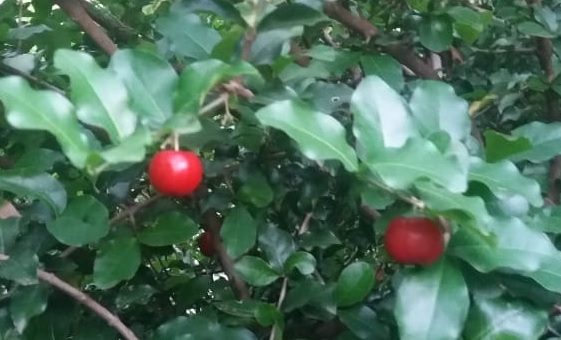Malpighia emarginata L. cultivation in Brazil: a integrative review
DOI:
https://doi.org/10.20873/jbb.uft.cemaf.v8n4.santosKeywords:
Malpighia, production, fruit, BrazilAbstract
The acerola, genus Malpighia, belongs to the family Malpighiaceae, this botanical family has a pantropical distribution, including 75 genera and about 1,300 species. Thus, this study aimed to carry out an integrative bibliographic review in specialized databases on the cultivation of acerola in Brazil. It was found that recently, in Brazil, there has been a considerable expansion of the area cultivated with acerola, genus Malpighia, this event is due to its nutritional qualities, having proteins, calcium, phosphorus, iron and vitamins A, B1, B2, and C, being the flagship with up to 100 times more than in other citrus fruits such as orange, lemon, etc., cultivation facilities and for having an excellent edaphoclimatic adaptation, such expansion is proven by the short time that the plant was spread in the country, since 1955, as it is a plant native to the Caribbean Islands, Central America and North South America. Its cultivation was intensified in the period from 1988 to 1992, due to its importance for human food, and today the Brazil is considered the largest producer of the fruit, with Malpighia emarginata DC and Malpighia glabra L. being the most commercially cultivated species. Generating productive, financial, and social benefits. The good acceptance of the fruit, both in natura fruit and its derivatives, by the national and international market is an important incentive for large-scale production.
References
Acerola (Malpighia emarginata DC.). 30 jul. 2016. Disponível em: http://organicamentefeliz.blogspot.com/2016/07/acerola.html. Acesso em: 26 maio 2019.
Alves GGN, Sebastiani R. Malpighiaceae na Reserva Biológica do Alto da Serra de Paranapiacaba, Santo André, SP, Brasil, São Paulo, 2015. Disponível em: http://www.scielo.br/scielo.php?script=sci_arttext&pid=S2236- 89062015000300521. Acesso em: 23 de maio 2019.
Alves RE et al. Adubando para alta produtividade e qualidade fruteiras tropicais do Brasil. Fortaleza-CE: A.E. Johnston, 2009.
Azevedo RB, Acerola. [S. l.], 2019. Disponível em: https://www.portalsaofrancisco.com.br/alimentos/acerola. Acesso em: 23 de maio 2019.
Barboza, SB; Tavares, ED; Melo, MB. instruções para o cultivo da acerola. Aracaju SE: Gráfica e Editora Triunfo Ltda., 1996.
Caetano PK, Daiuto ÉR, Vieites RL. Característica físico-química e sensorial de geleia elaborada com polpa e suco de acerola. Brazilian Journal of Food Technology, v.15, n.3, p.191-197, 2012.
Cavalcante ÍHL. Cultura da aceroleira. 2015. Disponível em: http://www.frutvasf.univasf.edu.br/images/aulaaceroleira.pdf. Acesso em: 23 de maio 2019.
Codevasf. Censo frutícola 2001. Brasília, 2001. Disponível em: <http://www.codevasf.gov.br/fruticultura/>. Acesso em: 18 de maio 2019
Cunha-Neto J, Rabelo MC, Bertini CHCM, Marques GV, Miranda MRA. Caracterização agronômica e potencial antio-xidante de frutos de clones de aceroleira. Revista Ciência Agronômica, v.43, n.4, p.713-721, 2012.
Ferreira, RMA et al. Ponto de colheita da acerola visando à produção industrial de polpa. Mossoró – RN, 2009. Disponível em: https://www.researchgate.net/publication/264992563_ponto_de_colheita_da_acerola_visando_a_producao_industrial_de_pol-pa_punto_de_cosecha_de_la_acerola_visando_a_la_produccion_industrial_de_pulpa. Acesso em: 11 de maio 2019.
Franzão AA, Melo BA. Cultura da Aceroleira. [S. l.], 2019. Disponível em: http://www.fruticultura.iciag.ufu.br/aceroleira.htm. Acesso em: 11 maio 2019.
Filho GAF, Leite JBV, Ramos JV. Acerola. [S. l.], 2019. Disponível em: http://www.ceplac.gov.br/radar/acerola.htm. Acesso em: 11 maio 2019.
Gomes JE, Perecin D, Martins ABG. Correlações entre os caracteres físico-químicos de frutos da aceroleira com variáveis meteorológicas. Revista brasileira de fruticultura, [s. L.], v. 24, ed. 1, 2002. Doi https://doi.org/10.1590/s0100-29452002000100024. Disponível em: https://www.scielo.br/scielo.php?script=sci_arttext&pid=s0100-29452002000100024. Acesso em: 24 set. 2020.
IBGE. Ranking - Acerola dos Estados do Brasil por Quantidade produzida. IBGE, [S. l.], 30 set. 2017. Disponível em: https://censos.ibge.gov.br/agro/2017/templates/censo_agro/resultadosagro/agricultura.html?localidade=0&tema=76215. Acesso em: 25 set. 2020.
Instituto Agronômico De Campinas. Acerola. São Paulo-SP, 2019. Disponível em: http://www.iac.sp.gov.br/areasdepesquisa/frutas/frutiferas_cont.php?nome=Acerola. Acesso em: 23 de maio 2019.
Joly AB. Botânica: introdução à taxonomia vegetal. 6.ed. São Paulo: Nacional, 1983. 778p.
Malpighia coccigera. [S. l.], 27 abr. 2016. Disponível em: https://mybonsai.com.br/articles/view/93. Acesso em: 25 maio 2019.
Mamede, MCH., Sebastiani, R., Almeida, RF., Francener, A, Amorim, AMA. 2015. Malpighiaceae. In: Lista de Espécies da Flora do Brasil. Jardim Botânico do Rio de Janeiro. Disponível em http://floradobrasil.jbrj.gov.br/jabot/floradobrasil/FB155 (acesso em: 25 set. 2020).
Mendes AMS. et al. A Cultura Da Acerola. Brasília, DF: Embrapa, 2012.
Paiva JR et al. Clones de aceroleira: BRS 235 ou Apodi, BRS 236 ou Cereja, BRS 237 ou Roxinha e BRS 238 ou Fruta-cor1. Fortaleza - CE, 2003. Disponível em: https://www.embrapa.br/busca-de-publicacoes/-/publicacao/425142/clones-de-aceroleira-brs-235-ou-apodi-brs-236-ou-cereja-brs-237-ou-roxinha-e-brs-238-ou-frutacor. Acesso em: 11 de maio 2019.
Patro R. Acerola – Malpighia emarginata. [S. l.], 23 set. 2014. Disponível em: https://www.jardineiro.net/plantas/acerola-malpighia-emarginata.html. Acesso em: 25 de maio 2019.
Ritzinger R, Ritzinger CHSP. Acerola. Informe Agropecuário, Belo Horizonte, 2011.
Teixeira S. Produção de acerola - principais variedades comerciais. 2019. Disponível em: https://www.cpt.com.br/artigos/producao-de-acerola-principais- variedades-comerciais. Acesso em: 26 maio 2019.
Silveira GCD, Rossi MFM, Peche PM. Acerola: Detalhes do cultivo no Brasil. Campo & Negócio Online, [s. L.], 24 jun. 2020. Disponível em: https://revistacampoenegocios.com.br/acerola-detalhes-do-cultivo-no-brasil/. Acesso em: 25 set. 2020.

Downloads
Published
How to Cite
Issue
Section
License
Copyright (c) 2024 - Journal of Biotechnology and Biodiversity

This work is licensed under a Creative Commons Attribution 4.0 International License.
Authors who publish with this journal agree to the following terms:
Authors retain copyright and grant the journal right of first publication with the work simultaneously licensed under a Creative Commons Attribution License (CC BY 4.0 at http://creativecommons.org/licenses/by/4.0/) that allows others to share the work with an acknowledgement of the work's authorship and initial publication in this journal.
Authors are able to enter into separate, additional contractual arrangements for the non-exclusive distribution of the journal's published version of the work (e.g., post it to an institutional repository or publish it in a book), with an acknowledgement of its initial publication in this journal.
Authors are permitted and encouraged to post their work online (e.g. in institutional repositories or on their website) prior to and during the submission process, as it can lead to productive exchanges, as well as earlier and greater citation of published work (Available at The Effect of Open Access, at http://opcit.eprints.org/oacitation-biblio.html).


